Consumer Behavior, Decision Making and Marketing Strategies Report
VerifiedAdded on 2022/12/16
|33
|4745
|290
Report
AI Summary
This report provides a comprehensive analysis of consumer behavior and decision-making processes, focusing on both Business-to-Consumer (B2C) and Business-to-Business (B2B) contexts. It explores the stages of the consumer decision-making journey, including need recognition, information search, evaluation, purchase, and post-purchase behavior, with specific examples related to Unilever. The report also examines the importance of mapping the customer's path to purchase and the factors that influence decision-making, such as heuristics, the marketing mix, and new technologies. It further differentiates between B2C and B2B decision-making processes, highlighting the different approaches to market research and methods used to understand these processes. The report concludes by evaluating how marketers can influence each stage of the decision-making process in both B2C and B2B environments, providing valuable insights for marketing professionals seeking to understand and influence consumer choices.
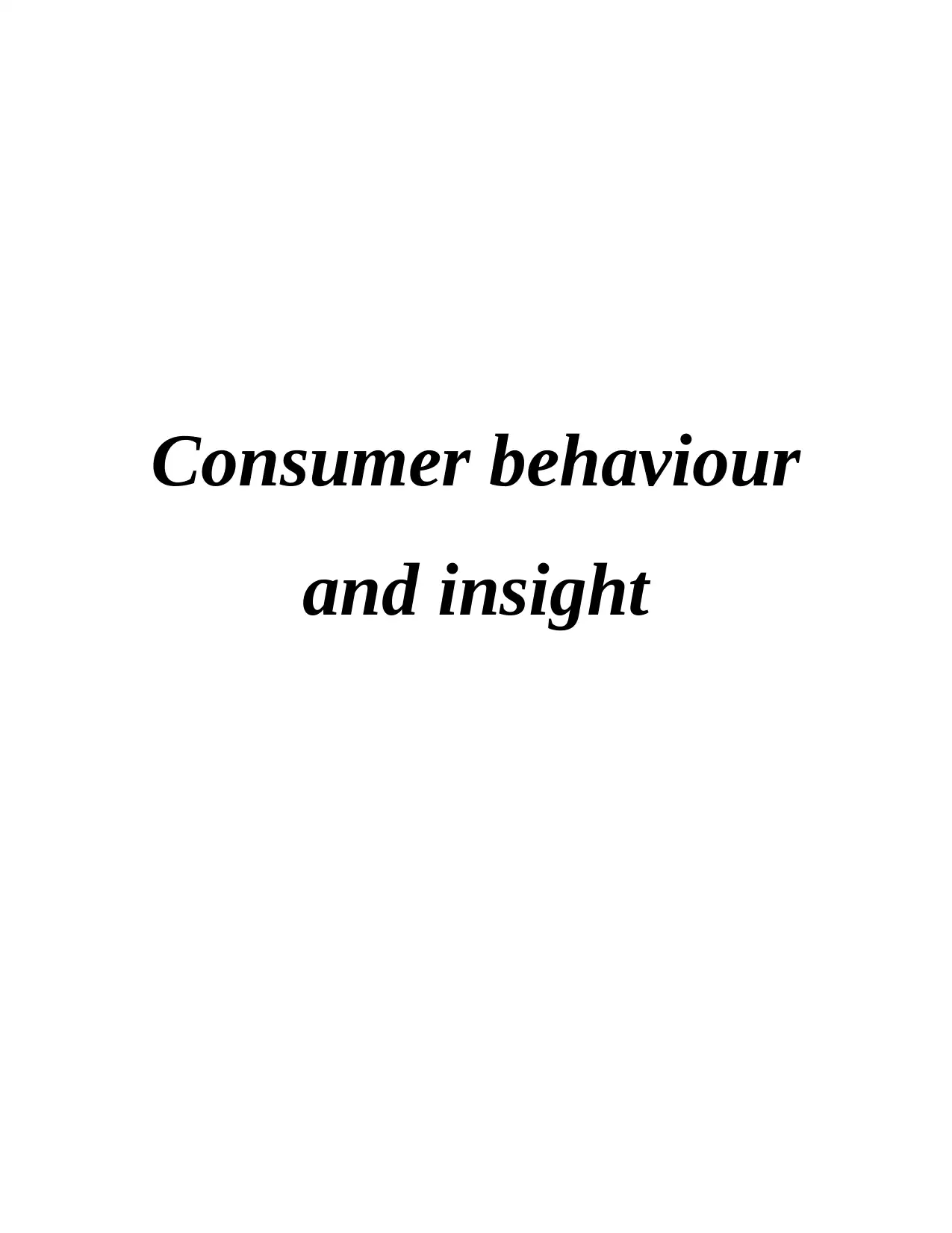
Consumer behaviour
and insight
and insight
Paraphrase This Document
Need a fresh take? Get an instant paraphrase of this document with our AI Paraphraser
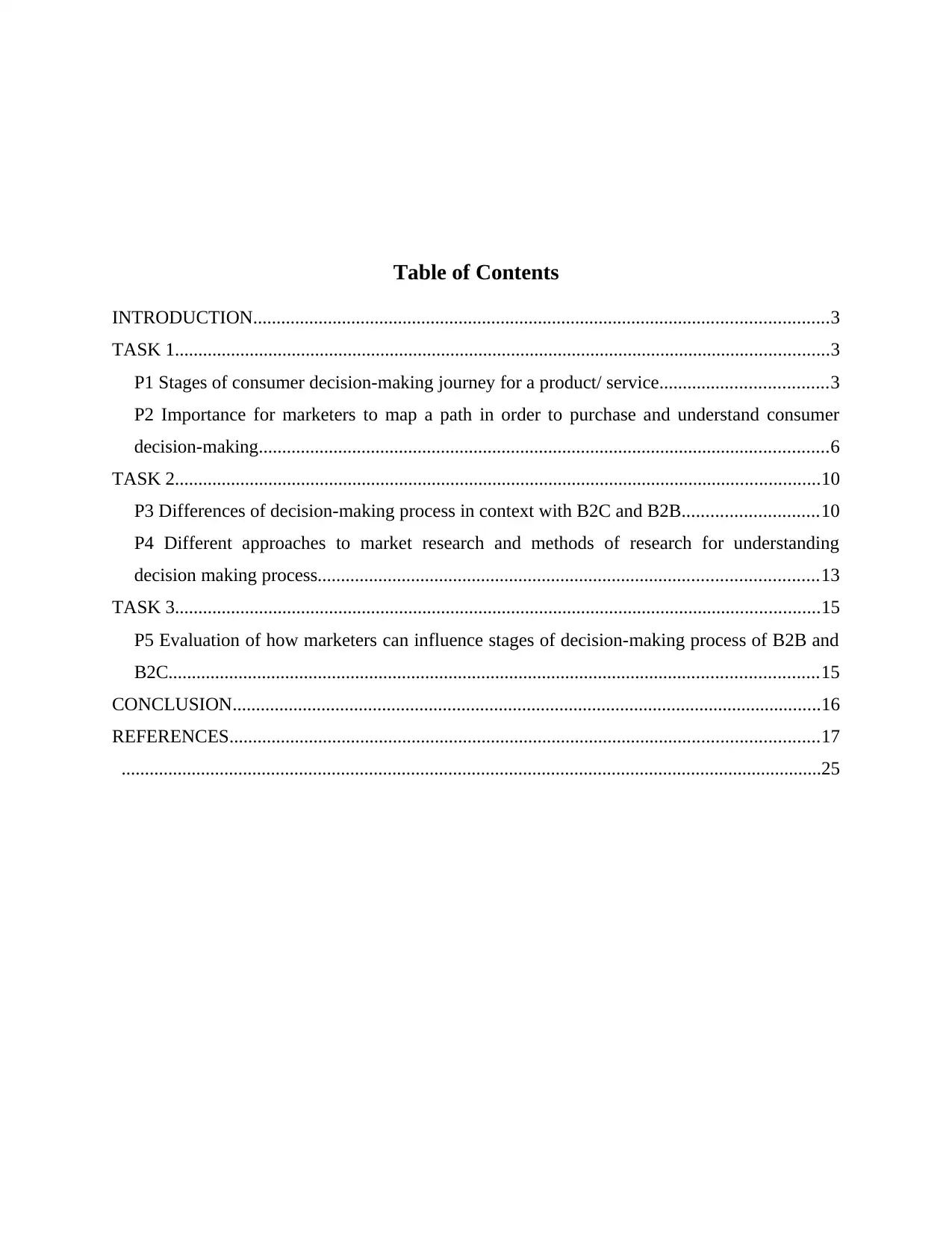
Table of Contents
INTRODUCTION...........................................................................................................................3
TASK 1............................................................................................................................................3
P1 Stages of consumer decision-making journey for a product/ service....................................3
P2 Importance for marketers to map a path in order to purchase and understand consumer
decision-making..........................................................................................................................6
TASK 2..........................................................................................................................................10
P3 Differences of decision-making process in context with B2C and B2B.............................10
P4 Different approaches to market research and methods of research for understanding
decision making process...........................................................................................................13
TASK 3..........................................................................................................................................15
P5 Evaluation of how marketers can influence stages of decision-making process of B2B and
B2C...........................................................................................................................................15
CONCLUSION..............................................................................................................................16
REFERENCES..............................................................................................................................17
......................................................................................................................................................25
INTRODUCTION...........................................................................................................................3
TASK 1............................................................................................................................................3
P1 Stages of consumer decision-making journey for a product/ service....................................3
P2 Importance for marketers to map a path in order to purchase and understand consumer
decision-making..........................................................................................................................6
TASK 2..........................................................................................................................................10
P3 Differences of decision-making process in context with B2C and B2B.............................10
P4 Different approaches to market research and methods of research for understanding
decision making process...........................................................................................................13
TASK 3..........................................................................................................................................15
P5 Evaluation of how marketers can influence stages of decision-making process of B2B and
B2C...........................................................................................................................................15
CONCLUSION..............................................................................................................................16
REFERENCES..............................................................................................................................17
......................................................................................................................................................25
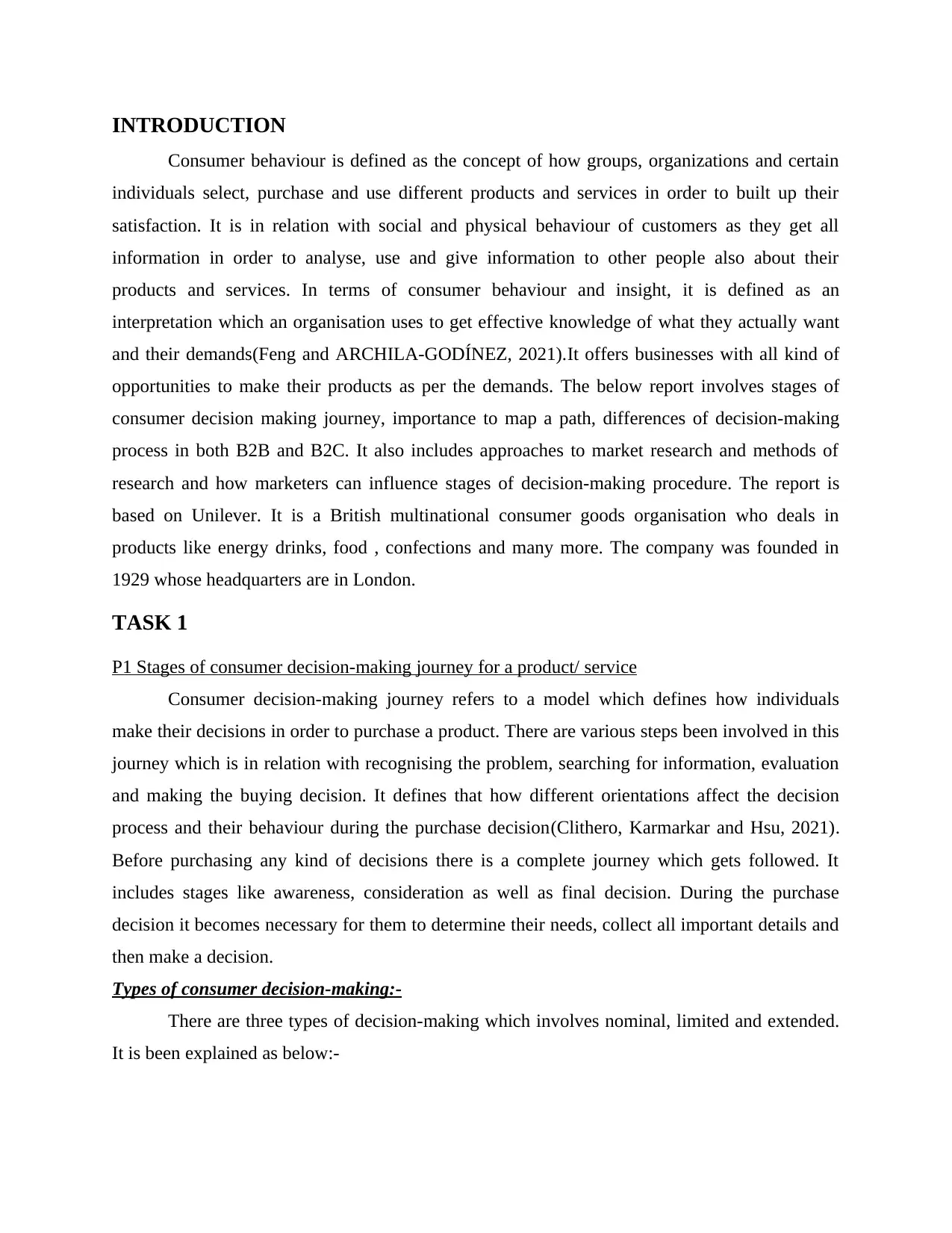
INTRODUCTION
Consumer behaviour is defined as the concept of how groups, organizations and certain
individuals select, purchase and use different products and services in order to built up their
satisfaction. It is in relation with social and physical behaviour of customers as they get all
information in order to analyse, use and give information to other people also about their
products and services. In terms of consumer behaviour and insight, it is defined as an
interpretation which an organisation uses to get effective knowledge of what they actually want
and their demands(Feng and ARCHILA-GODÍNEZ, 2021). It offers businesses with all kind of
opportunities to make their products as per the demands. The below report involves stages of
consumer decision making journey, importance to map a path, differences of decision-making
process in both B2B and B2C. It also includes approaches to market research and methods of
research and how marketers can influence stages of decision-making procedure. The report is
based on Unilever. It is a British multinational consumer goods organisation who deals in
products like energy drinks, food , confections and many more. The company was founded in
1929 whose headquarters are in London.
TASK 1
P1 Stages of consumer decision-making journey for a product/ service
Consumer decision-making journey refers to a model which defines how individuals
make their decisions in order to purchase a product. There are various steps been involved in this
journey which is in relation with recognising the problem, searching for information, evaluation
and making the buying decision. It defines that how different orientations affect the decision
process and their behaviour during the purchase decision(Clithero, Karmarkar and Hsu, 2021).
Before purchasing any kind of decisions there is a complete journey which gets followed. It
includes stages like awareness, consideration as well as final decision. During the purchase
decision it becomes necessary for them to determine their needs, collect all important details and
then make a decision.
Types of consumer decision-making:-
There are three types of decision-making which involves nominal, limited and extended.
It is been explained as below:-
Consumer behaviour is defined as the concept of how groups, organizations and certain
individuals select, purchase and use different products and services in order to built up their
satisfaction. It is in relation with social and physical behaviour of customers as they get all
information in order to analyse, use and give information to other people also about their
products and services. In terms of consumer behaviour and insight, it is defined as an
interpretation which an organisation uses to get effective knowledge of what they actually want
and their demands(Feng and ARCHILA-GODÍNEZ, 2021). It offers businesses with all kind of
opportunities to make their products as per the demands. The below report involves stages of
consumer decision making journey, importance to map a path, differences of decision-making
process in both B2B and B2C. It also includes approaches to market research and methods of
research and how marketers can influence stages of decision-making procedure. The report is
based on Unilever. It is a British multinational consumer goods organisation who deals in
products like energy drinks, food , confections and many more. The company was founded in
1929 whose headquarters are in London.
TASK 1
P1 Stages of consumer decision-making journey for a product/ service
Consumer decision-making journey refers to a model which defines how individuals
make their decisions in order to purchase a product. There are various steps been involved in this
journey which is in relation with recognising the problem, searching for information, evaluation
and making the buying decision. It defines that how different orientations affect the decision
process and their behaviour during the purchase decision(Clithero, Karmarkar and Hsu, 2021).
Before purchasing any kind of decisions there is a complete journey which gets followed. It
includes stages like awareness, consideration as well as final decision. During the purchase
decision it becomes necessary for them to determine their needs, collect all important details and
then make a decision.
Types of consumer decision-making:-
There are three types of decision-making which involves nominal, limited and extended.
It is been explained as below:-
⊘ This is a preview!⊘
Do you want full access?
Subscribe today to unlock all pages.

Trusted by 1+ million students worldwide
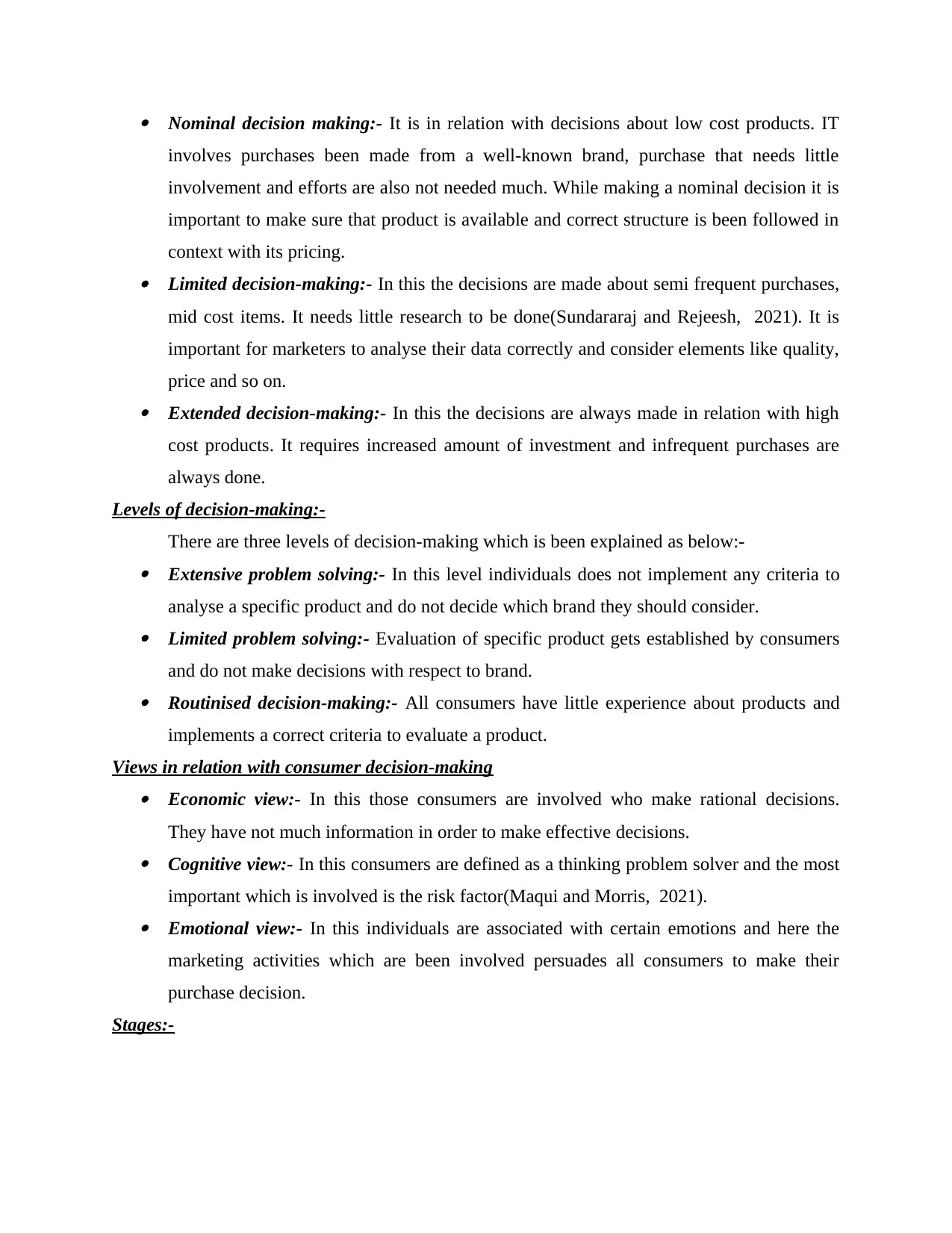
Nominal decision making:- It is in relation with decisions about low cost products. IT
involves purchases been made from a well-known brand, purchase that needs little
involvement and efforts are also not needed much. While making a nominal decision it is
important to make sure that product is available and correct structure is been followed in
context with its pricing. Limited decision-making:- In this the decisions are made about semi frequent purchases,
mid cost items. It needs little research to be done(Sundararaj and Rejeesh, 2021). It is
important for marketers to analyse their data correctly and consider elements like quality,
price and so on. Extended decision-making:- In this the decisions are always made in relation with high
cost products. It requires increased amount of investment and infrequent purchases are
always done.
Levels of decision-making:-
There are three levels of decision-making which is been explained as below:- Extensive problem solving:- In this level individuals does not implement any criteria to
analyse a specific product and do not decide which brand they should consider. Limited problem solving:- Evaluation of specific product gets established by consumers
and do not make decisions with respect to brand. Routinised decision-making:- All consumers have little experience about products and
implements a correct criteria to evaluate a product.
Views in relation with consumer decision-making Economic view:- In this those consumers are involved who make rational decisions.
They have not much information in order to make effective decisions. Cognitive view:- In this consumers are defined as a thinking problem solver and the most
important which is involved is the risk factor(Maqui and Morris, 2021). Emotional view:- In this individuals are associated with certain emotions and here the
marketing activities which are been involved persuades all consumers to make their
purchase decision.
Stages:-
involves purchases been made from a well-known brand, purchase that needs little
involvement and efforts are also not needed much. While making a nominal decision it is
important to make sure that product is available and correct structure is been followed in
context with its pricing. Limited decision-making:- In this the decisions are made about semi frequent purchases,
mid cost items. It needs little research to be done(Sundararaj and Rejeesh, 2021). It is
important for marketers to analyse their data correctly and consider elements like quality,
price and so on. Extended decision-making:- In this the decisions are always made in relation with high
cost products. It requires increased amount of investment and infrequent purchases are
always done.
Levels of decision-making:-
There are three levels of decision-making which is been explained as below:- Extensive problem solving:- In this level individuals does not implement any criteria to
analyse a specific product and do not decide which brand they should consider. Limited problem solving:- Evaluation of specific product gets established by consumers
and do not make decisions with respect to brand. Routinised decision-making:- All consumers have little experience about products and
implements a correct criteria to evaluate a product.
Views in relation with consumer decision-making Economic view:- In this those consumers are involved who make rational decisions.
They have not much information in order to make effective decisions. Cognitive view:- In this consumers are defined as a thinking problem solver and the most
important which is involved is the risk factor(Maqui and Morris, 2021). Emotional view:- In this individuals are associated with certain emotions and here the
marketing activities which are been involved persuades all consumers to make their
purchase decision.
Stages:-
Paraphrase This Document
Need a fresh take? Get an instant paraphrase of this document with our AI Paraphraser
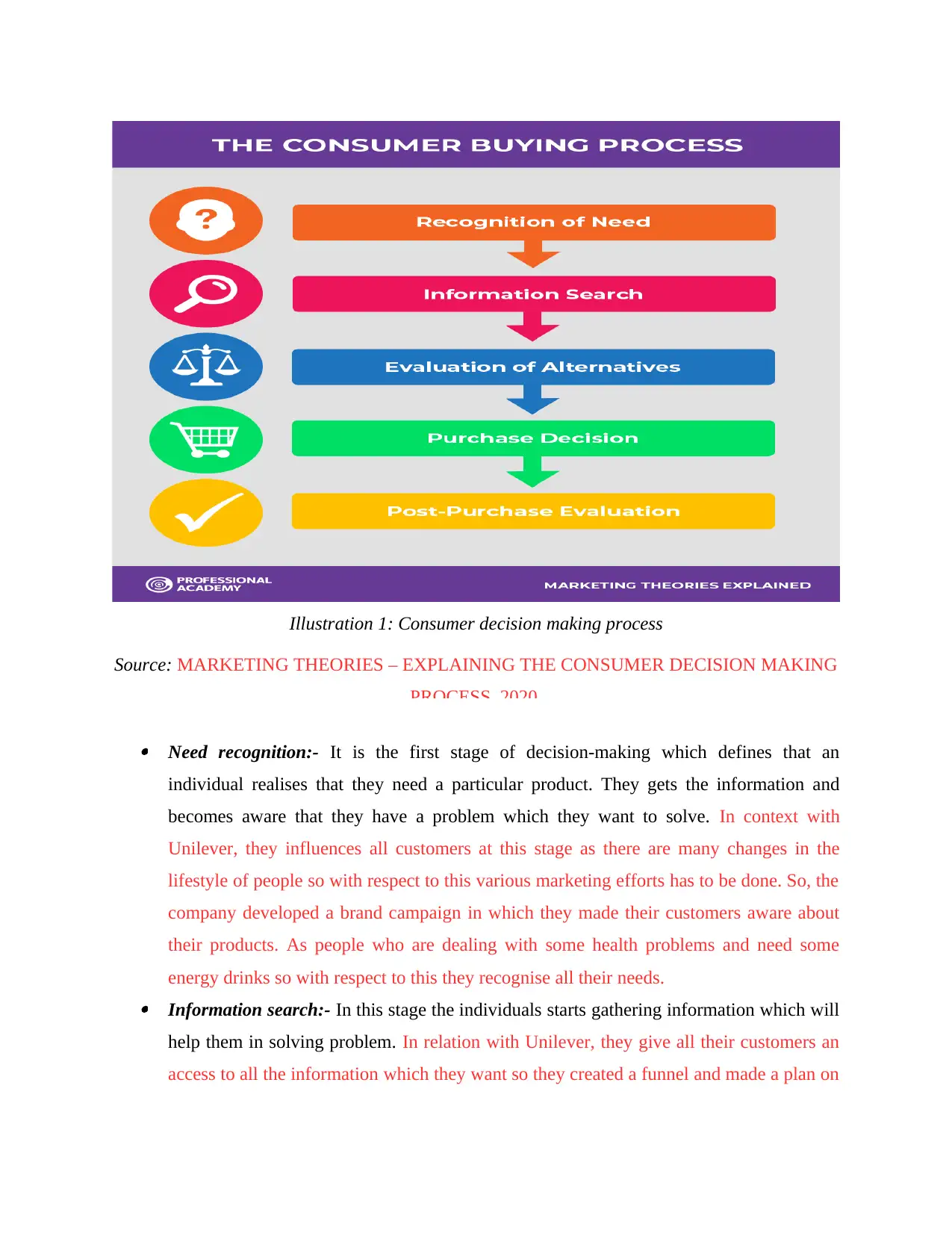
Need recognition:- It is the first stage of decision-making which defines that an
individual realises that they need a particular product. They gets the information and
becomes aware that they have a problem which they want to solve. In context with
Unilever, they influences all customers at this stage as there are many changes in the
lifestyle of people so with respect to this various marketing efforts has to be done. So, the
company developed a brand campaign in which they made their customers aware about
their products. As people who are dealing with some health problems and need some
energy drinks so with respect to this they recognise all their needs. Information search:- In this stage the individuals starts gathering information which will
help them in solving problem. In relation with Unilever, they give all their customers an
access to all the information which they want so they created a funnel and made a plan on
Illustration 1: Consumer decision making process
Source: MARKETING THEORIES – EXPLAINING THE CONSUMER DECISION MAKING
PROCESS, 2020.
individual realises that they need a particular product. They gets the information and
becomes aware that they have a problem which they want to solve. In context with
Unilever, they influences all customers at this stage as there are many changes in the
lifestyle of people so with respect to this various marketing efforts has to be done. So, the
company developed a brand campaign in which they made their customers aware about
their products. As people who are dealing with some health problems and need some
energy drinks so with respect to this they recognise all their needs. Information search:- In this stage the individuals starts gathering information which will
help them in solving problem. In relation with Unilever, they give all their customers an
access to all the information which they want so they created a funnel and made a plan on
Illustration 1: Consumer decision making process
Source: MARKETING THEORIES – EXPLAINING THE CONSUMER DECISION MAKING
PROCESS, 2020.
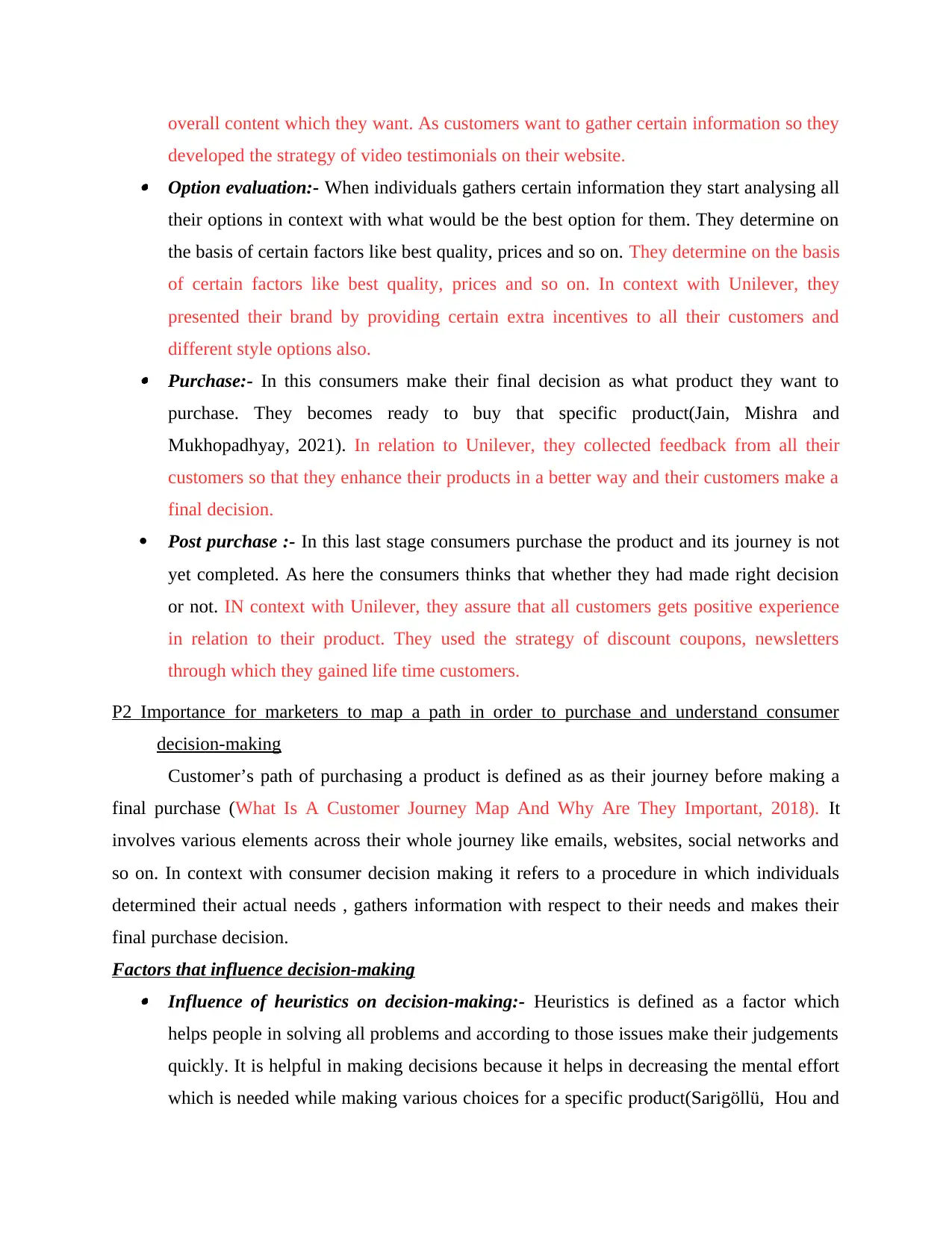
overall content which they want. As customers want to gather certain information so they
developed the strategy of video testimonials on their website. Option evaluation:- When individuals gathers certain information they start analysing all
their options in context with what would be the best option for them. They determine on
the basis of certain factors like best quality, prices and so on. They determine on the basis
of certain factors like best quality, prices and so on. In context with Unilever, they
presented their brand by providing certain extra incentives to all their customers and
different style options also. Purchase:- In this consumers make their final decision as what product they want to
purchase. They becomes ready to buy that specific product(Jain, Mishra and
Mukhopadhyay, 2021). In relation to Unilever, they collected feedback from all their
customers so that they enhance their products in a better way and their customers make a
final decision.
Post purchase :- In this last stage consumers purchase the product and its journey is not
yet completed. As here the consumers thinks that whether they had made right decision
or not. IN context with Unilever, they assure that all customers gets positive experience
in relation to their product. They used the strategy of discount coupons, newsletters
through which they gained life time customers.
P2 Importance for marketers to map a path in order to purchase and understand consumer
decision-making
Customer’s path of purchasing a product is defined as as their journey before making a
final purchase (What Is A Customer Journey Map And Why Are They Important, 2018). It
involves various elements across their whole journey like emails, websites, social networks and
so on. In context with consumer decision making it refers to a procedure in which individuals
determined their actual needs , gathers information with respect to their needs and makes their
final purchase decision.
Factors that influence decision-making Influence of heuristics on decision-making:- Heuristics is defined as a factor which
helps people in solving all problems and according to those issues make their judgements
quickly. It is helpful in making decisions because it helps in decreasing the mental effort
which is needed while making various choices for a specific product(Sarigöllü, Hou and
developed the strategy of video testimonials on their website. Option evaluation:- When individuals gathers certain information they start analysing all
their options in context with what would be the best option for them. They determine on
the basis of certain factors like best quality, prices and so on. They determine on the basis
of certain factors like best quality, prices and so on. In context with Unilever, they
presented their brand by providing certain extra incentives to all their customers and
different style options also. Purchase:- In this consumers make their final decision as what product they want to
purchase. They becomes ready to buy that specific product(Jain, Mishra and
Mukhopadhyay, 2021). In relation to Unilever, they collected feedback from all their
customers so that they enhance their products in a better way and their customers make a
final decision.
Post purchase :- In this last stage consumers purchase the product and its journey is not
yet completed. As here the consumers thinks that whether they had made right decision
or not. IN context with Unilever, they assure that all customers gets positive experience
in relation to their product. They used the strategy of discount coupons, newsletters
through which they gained life time customers.
P2 Importance for marketers to map a path in order to purchase and understand consumer
decision-making
Customer’s path of purchasing a product is defined as as their journey before making a
final purchase (What Is A Customer Journey Map And Why Are They Important, 2018). It
involves various elements across their whole journey like emails, websites, social networks and
so on. In context with consumer decision making it refers to a procedure in which individuals
determined their actual needs , gathers information with respect to their needs and makes their
final purchase decision.
Factors that influence decision-making Influence of heuristics on decision-making:- Heuristics is defined as a factor which
helps people in solving all problems and according to those issues make their judgements
quickly. It is helpful in making decisions because it helps in decreasing the mental effort
which is needed while making various choices for a specific product(Sarigöllü, Hou and
⊘ This is a preview!⊘
Do you want full access?
Subscribe today to unlock all pages.

Trusted by 1+ million students worldwide
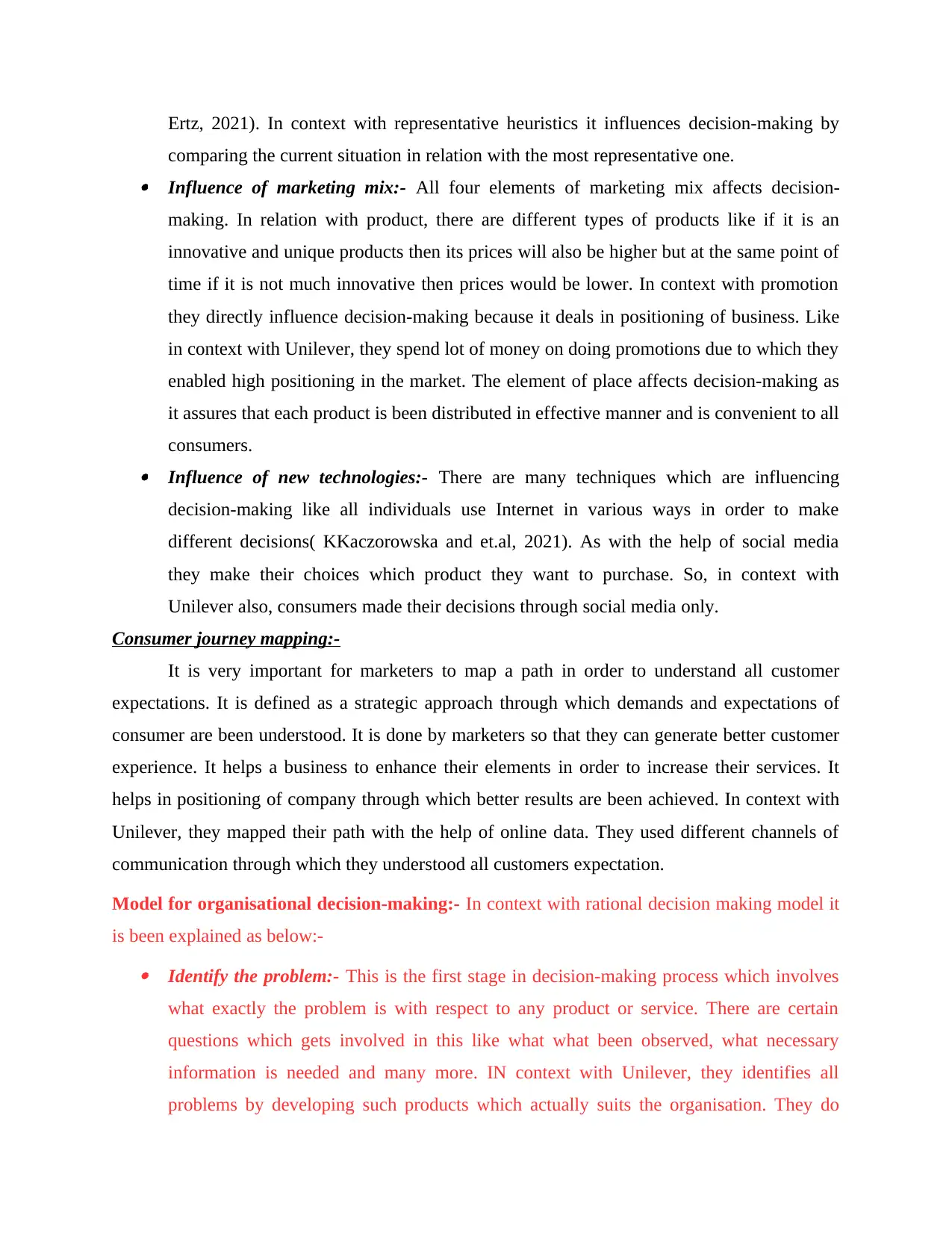
Ertz, 2021). In context with representative heuristics it influences decision-making by
comparing the current situation in relation with the most representative one. Influence of marketing mix:- All four elements of marketing mix affects decision-
making. In relation with product, there are different types of products like if it is an
innovative and unique products then its prices will also be higher but at the same point of
time if it is not much innovative then prices would be lower. In context with promotion
they directly influence decision-making because it deals in positioning of business. Like
in context with Unilever, they spend lot of money on doing promotions due to which they
enabled high positioning in the market. The element of place affects decision-making as
it assures that each product is been distributed in effective manner and is convenient to all
consumers. Influence of new technologies:- There are many techniques which are influencing
decision-making like all individuals use Internet in various ways in order to make
different decisions( KKaczorowska and et.al, 2021). As with the help of social media
they make their choices which product they want to purchase. So, in context with
Unilever also, consumers made their decisions through social media only.
Consumer journey mapping:-
It is very important for marketers to map a path in order to understand all customer
expectations. It is defined as a strategic approach through which demands and expectations of
consumer are been understood. It is done by marketers so that they can generate better customer
experience. It helps a business to enhance their elements in order to increase their services. It
helps in positioning of company through which better results are been achieved. In context with
Unilever, they mapped their path with the help of online data. They used different channels of
communication through which they understood all customers expectation.
Model for organisational decision-making:- In context with rational decision making model it
is been explained as below:- Identify the problem:- This is the first stage in decision-making process which involves
what exactly the problem is with respect to any product or service. There are certain
questions which gets involved in this like what what been observed, what necessary
information is needed and many more. IN context with Unilever, they identifies all
problems by developing such products which actually suits the organisation. They do
comparing the current situation in relation with the most representative one. Influence of marketing mix:- All four elements of marketing mix affects decision-
making. In relation with product, there are different types of products like if it is an
innovative and unique products then its prices will also be higher but at the same point of
time if it is not much innovative then prices would be lower. In context with promotion
they directly influence decision-making because it deals in positioning of business. Like
in context with Unilever, they spend lot of money on doing promotions due to which they
enabled high positioning in the market. The element of place affects decision-making as
it assures that each product is been distributed in effective manner and is convenient to all
consumers. Influence of new technologies:- There are many techniques which are influencing
decision-making like all individuals use Internet in various ways in order to make
different decisions( KKaczorowska and et.al, 2021). As with the help of social media
they make their choices which product they want to purchase. So, in context with
Unilever also, consumers made their decisions through social media only.
Consumer journey mapping:-
It is very important for marketers to map a path in order to understand all customer
expectations. It is defined as a strategic approach through which demands and expectations of
consumer are been understood. It is done by marketers so that they can generate better customer
experience. It helps a business to enhance their elements in order to increase their services. It
helps in positioning of company through which better results are been achieved. In context with
Unilever, they mapped their path with the help of online data. They used different channels of
communication through which they understood all customers expectation.
Model for organisational decision-making:- In context with rational decision making model it
is been explained as below:- Identify the problem:- This is the first stage in decision-making process which involves
what exactly the problem is with respect to any product or service. There are certain
questions which gets involved in this like what what been observed, what necessary
information is needed and many more. IN context with Unilever, they identifies all
problems by developing such products which actually suits the organisation. They do
Paraphrase This Document
Need a fresh take? Get an instant paraphrase of this document with our AI Paraphraser
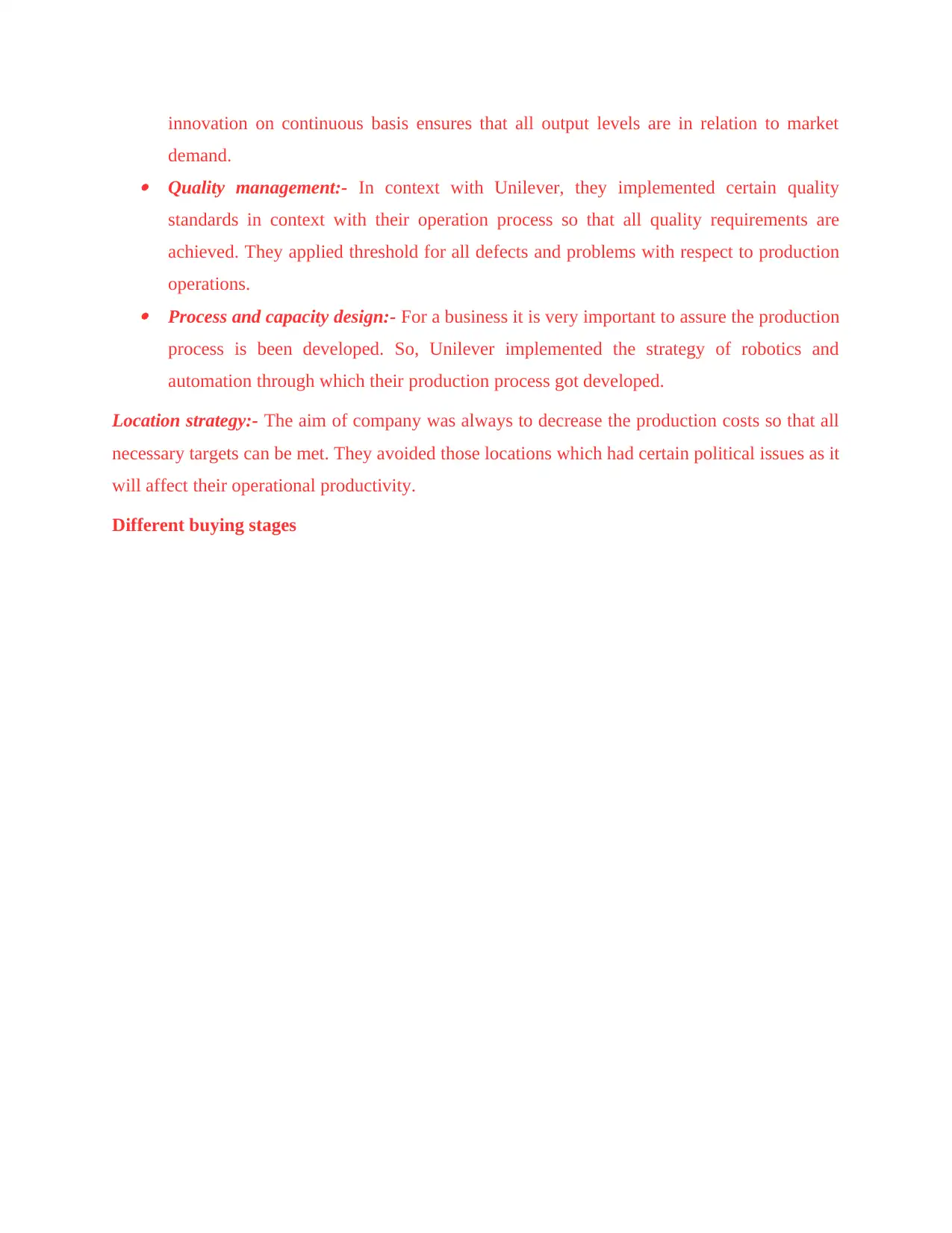
innovation on continuous basis ensures that all output levels are in relation to market
demand. Quality management:- In context with Unilever, they implemented certain quality
standards in context with their operation process so that all quality requirements are
achieved. They applied threshold for all defects and problems with respect to production
operations. Process and capacity design:- For a business it is very important to assure the production
process is been developed. So, Unilever implemented the strategy of robotics and
automation through which their production process got developed.
Location strategy:- The aim of company was always to decrease the production costs so that all
necessary targets can be met. They avoided those locations which had certain political issues as it
will affect their operational productivity.
Different buying stages
demand. Quality management:- In context with Unilever, they implemented certain quality
standards in context with their operation process so that all quality requirements are
achieved. They applied threshold for all defects and problems with respect to production
operations. Process and capacity design:- For a business it is very important to assure the production
process is been developed. So, Unilever implemented the strategy of robotics and
automation through which their production process got developed.
Location strategy:- The aim of company was always to decrease the production costs so that all
necessary targets can be met. They avoided those locations which had certain political issues as it
will affect their operational productivity.
Different buying stages
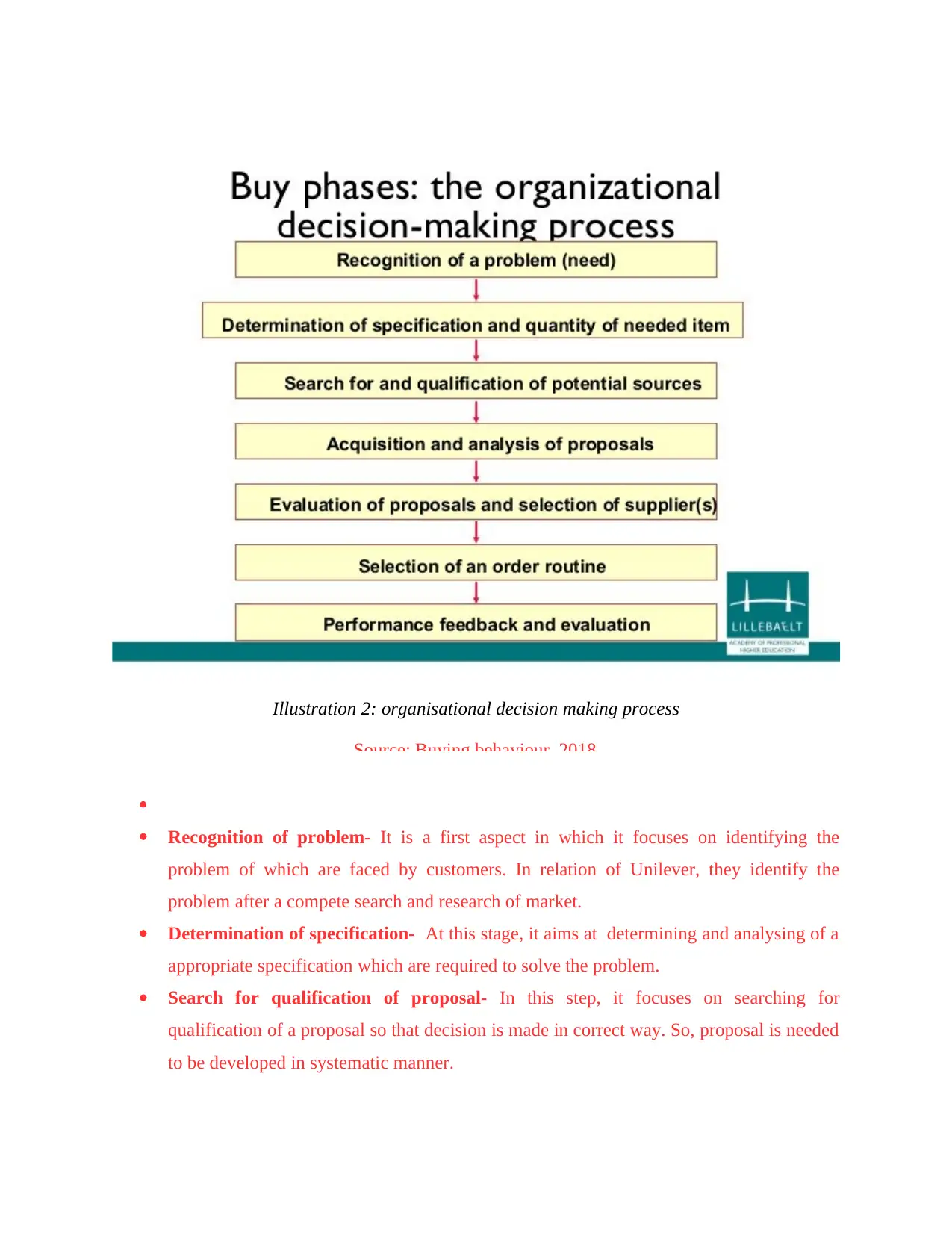
Recognition of problem- It is a first aspect in which it focuses on identifying the
problem of which are faced by customers. In relation of Unilever, they identify the
problem after a compete search and research of market.
Determination of specification- At this stage, it aims at determining and analysing of a
appropriate specification which are required to solve the problem.
Search for qualification of proposal- In this step, it focuses on searching for
qualification of a proposal so that decision is made in correct way. So, proposal is needed
to be developed in systematic manner.
Illustration 2: organisational decision making process
Source: Buying behaviour, 2018.
Recognition of problem- It is a first aspect in which it focuses on identifying the
problem of which are faced by customers. In relation of Unilever, they identify the
problem after a compete search and research of market.
Determination of specification- At this stage, it aims at determining and analysing of a
appropriate specification which are required to solve the problem.
Search for qualification of proposal- In this step, it focuses on searching for
qualification of a proposal so that decision is made in correct way. So, proposal is needed
to be developed in systematic manner.
Illustration 2: organisational decision making process
Source: Buying behaviour, 2018.
⊘ This is a preview!⊘
Do you want full access?
Subscribe today to unlock all pages.

Trusted by 1+ million students worldwide
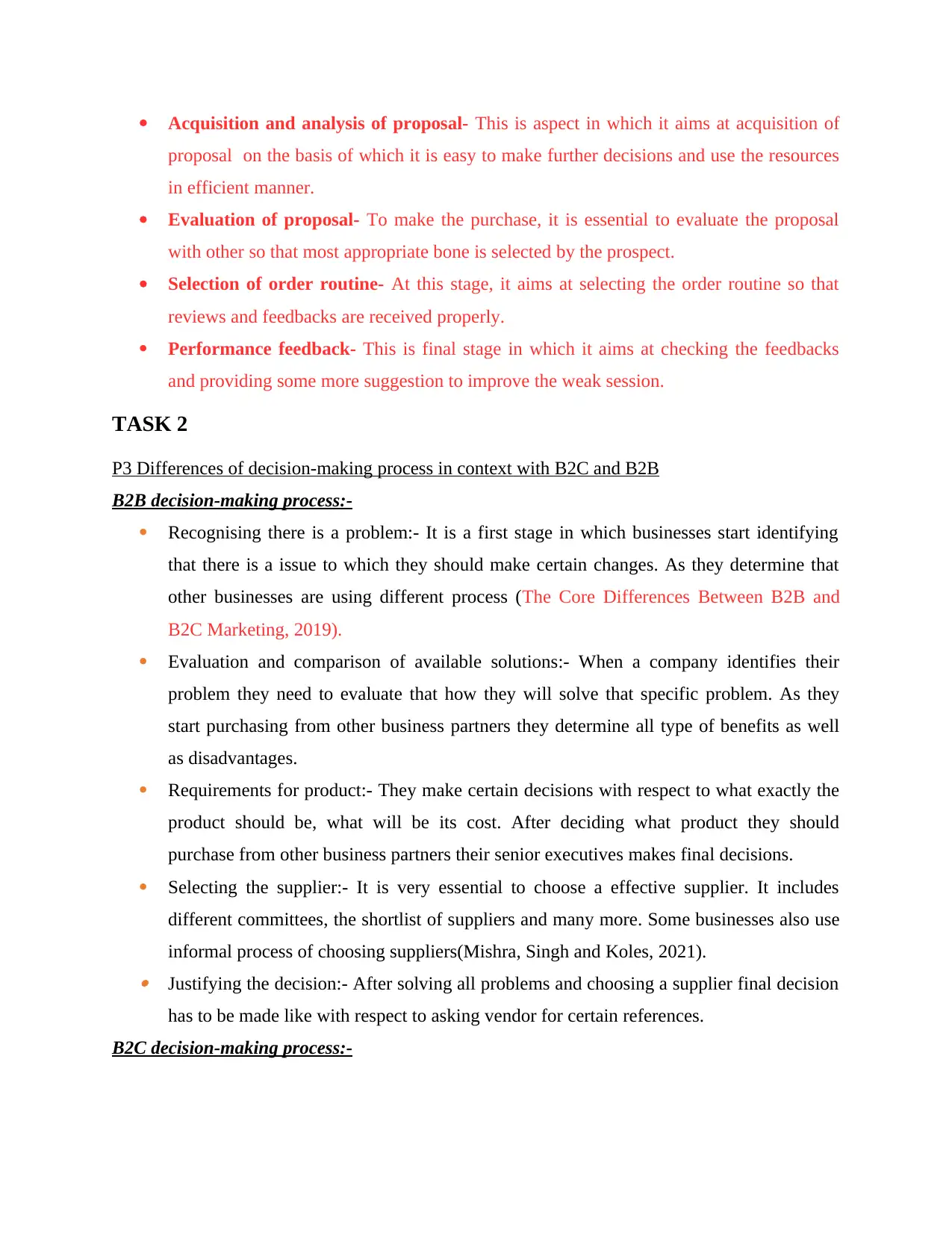
Acquisition and analysis of proposal- This is aspect in which it aims at acquisition of
proposal on the basis of which it is easy to make further decisions and use the resources
in efficient manner.
Evaluation of proposal- To make the purchase, it is essential to evaluate the proposal
with other so that most appropriate bone is selected by the prospect.
Selection of order routine- At this stage, it aims at selecting the order routine so that
reviews and feedbacks are received properly.
Performance feedback- This is final stage in which it aims at checking the feedbacks
and providing some more suggestion to improve the weak session.
TASK 2
P3 Differences of decision-making process in context with B2C and B2B
B2B decision-making process:-
Recognising there is a problem:- It is a first stage in which businesses start identifying
that there is a issue to which they should make certain changes. As they determine that
other businesses are using different process (The Core Differences Between B2B and
B2C Marketing, 2019).
Evaluation and comparison of available solutions:- When a company identifies their
problem they need to evaluate that how they will solve that specific problem. As they
start purchasing from other business partners they determine all type of benefits as well
as disadvantages.
Requirements for product:- They make certain decisions with respect to what exactly the
product should be, what will be its cost. After deciding what product they should
purchase from other business partners their senior executives makes final decisions.
Selecting the supplier:- It is very essential to choose a effective supplier. It includes
different committees, the shortlist of suppliers and many more. Some businesses also use
informal process of choosing suppliers(Mishra, Singh and Koles, 2021). Justifying the decision:- After solving all problems and choosing a supplier final decision
has to be made like with respect to asking vendor for certain references.
B2C decision-making process:-
proposal on the basis of which it is easy to make further decisions and use the resources
in efficient manner.
Evaluation of proposal- To make the purchase, it is essential to evaluate the proposal
with other so that most appropriate bone is selected by the prospect.
Selection of order routine- At this stage, it aims at selecting the order routine so that
reviews and feedbacks are received properly.
Performance feedback- This is final stage in which it aims at checking the feedbacks
and providing some more suggestion to improve the weak session.
TASK 2
P3 Differences of decision-making process in context with B2C and B2B
B2B decision-making process:-
Recognising there is a problem:- It is a first stage in which businesses start identifying
that there is a issue to which they should make certain changes. As they determine that
other businesses are using different process (The Core Differences Between B2B and
B2C Marketing, 2019).
Evaluation and comparison of available solutions:- When a company identifies their
problem they need to evaluate that how they will solve that specific problem. As they
start purchasing from other business partners they determine all type of benefits as well
as disadvantages.
Requirements for product:- They make certain decisions with respect to what exactly the
product should be, what will be its cost. After deciding what product they should
purchase from other business partners their senior executives makes final decisions.
Selecting the supplier:- It is very essential to choose a effective supplier. It includes
different committees, the shortlist of suppliers and many more. Some businesses also use
informal process of choosing suppliers(Mishra, Singh and Koles, 2021). Justifying the decision:- After solving all problems and choosing a supplier final decision
has to be made like with respect to asking vendor for certain references.
B2C decision-making process:-
Paraphrase This Document
Need a fresh take? Get an instant paraphrase of this document with our AI Paraphraser
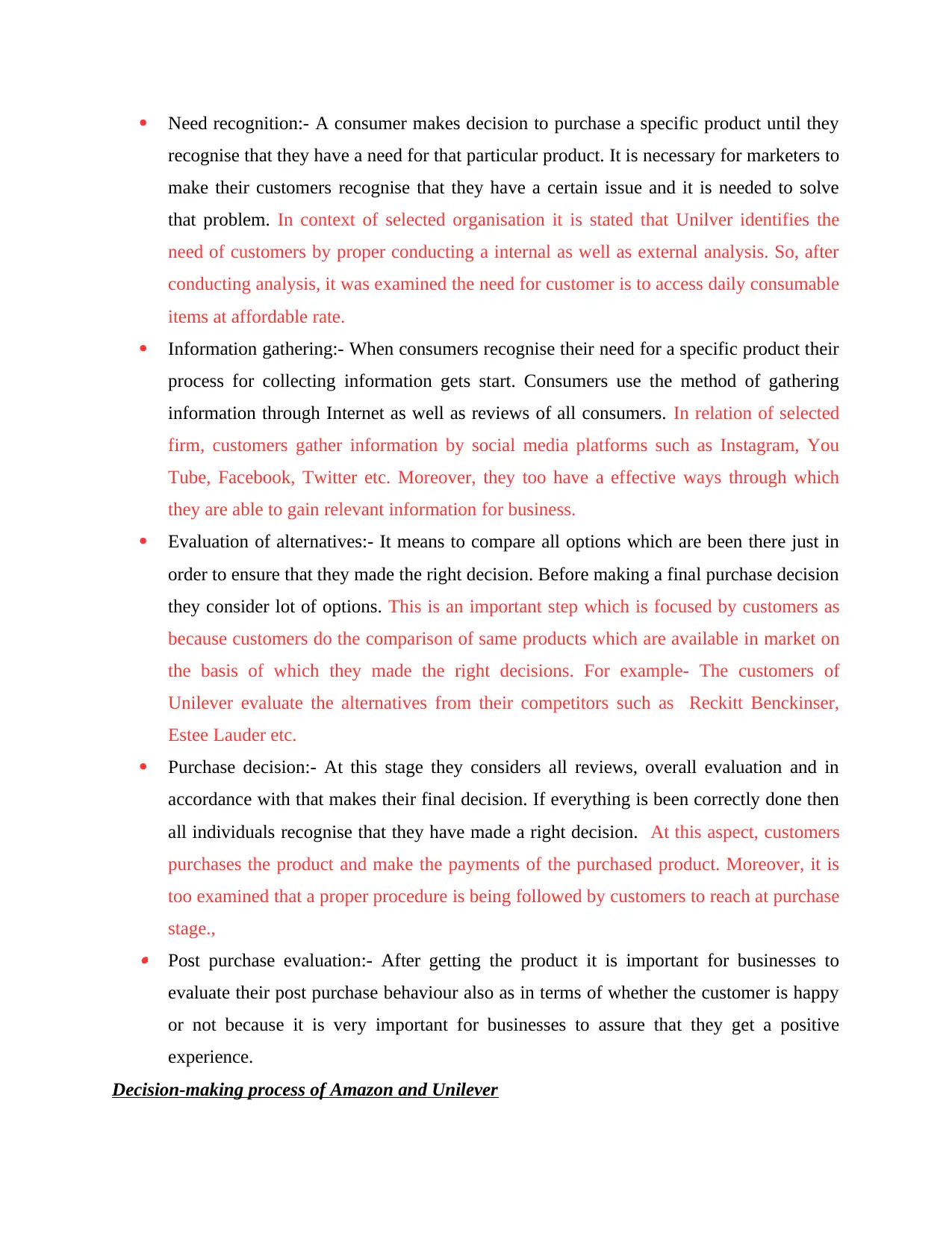
Need recognition:- A consumer makes decision to purchase a specific product until they
recognise that they have a need for that particular product. It is necessary for marketers to
make their customers recognise that they have a certain issue and it is needed to solve
that problem. In context of selected organisation it is stated that Unilver identifies the
need of customers by proper conducting a internal as well as external analysis. So, after
conducting analysis, it was examined the need for customer is to access daily consumable
items at affordable rate.
Information gathering:- When consumers recognise their need for a specific product their
process for collecting information gets start. Consumers use the method of gathering
information through Internet as well as reviews of all consumers. In relation of selected
firm, customers gather information by social media platforms such as Instagram, You
Tube, Facebook, Twitter etc. Moreover, they too have a effective ways through which
they are able to gain relevant information for business.
Evaluation of alternatives:- It means to compare all options which are been there just in
order to ensure that they made the right decision. Before making a final purchase decision
they consider lot of options. This is an important step which is focused by customers as
because customers do the comparison of same products which are available in market on
the basis of which they made the right decisions. For example- The customers of
Unilever evaluate the alternatives from their competitors such as Reckitt Benckinser,
Estee Lauder etc.
Purchase decision:- At this stage they considers all reviews, overall evaluation and in
accordance with that makes their final decision. If everything is been correctly done then
all individuals recognise that they have made a right decision. At this aspect, customers
purchases the product and make the payments of the purchased product. Moreover, it is
too examined that a proper procedure is being followed by customers to reach at purchase
stage., Post purchase evaluation:- After getting the product it is important for businesses to
evaluate their post purchase behaviour also as in terms of whether the customer is happy
or not because it is very important for businesses to assure that they get a positive
experience.
Decision-making process of Amazon and Unilever
recognise that they have a need for that particular product. It is necessary for marketers to
make their customers recognise that they have a certain issue and it is needed to solve
that problem. In context of selected organisation it is stated that Unilver identifies the
need of customers by proper conducting a internal as well as external analysis. So, after
conducting analysis, it was examined the need for customer is to access daily consumable
items at affordable rate.
Information gathering:- When consumers recognise their need for a specific product their
process for collecting information gets start. Consumers use the method of gathering
information through Internet as well as reviews of all consumers. In relation of selected
firm, customers gather information by social media platforms such as Instagram, You
Tube, Facebook, Twitter etc. Moreover, they too have a effective ways through which
they are able to gain relevant information for business.
Evaluation of alternatives:- It means to compare all options which are been there just in
order to ensure that they made the right decision. Before making a final purchase decision
they consider lot of options. This is an important step which is focused by customers as
because customers do the comparison of same products which are available in market on
the basis of which they made the right decisions. For example- The customers of
Unilever evaluate the alternatives from their competitors such as Reckitt Benckinser,
Estee Lauder etc.
Purchase decision:- At this stage they considers all reviews, overall evaluation and in
accordance with that makes their final decision. If everything is been correctly done then
all individuals recognise that they have made a right decision. At this aspect, customers
purchases the product and make the payments of the purchased product. Moreover, it is
too examined that a proper procedure is being followed by customers to reach at purchase
stage., Post purchase evaluation:- After getting the product it is important for businesses to
evaluate their post purchase behaviour also as in terms of whether the customer is happy
or not because it is very important for businesses to assure that they get a positive
experience.
Decision-making process of Amazon and Unilever
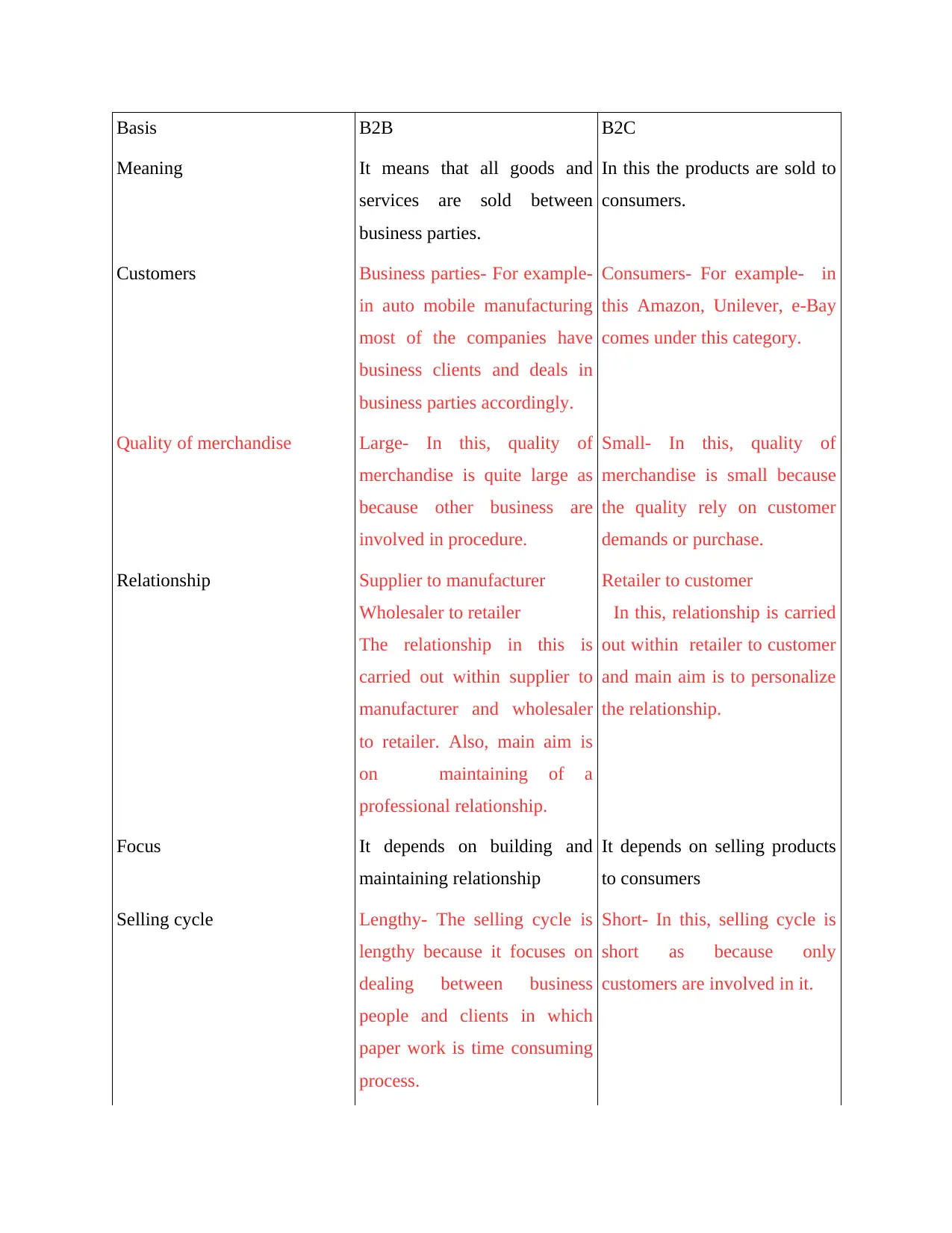
Basis B2B B2C
Meaning It means that all goods and
services are sold between
business parties.
In this the products are sold to
consumers.
Customers Business parties- For example-
in auto mobile manufacturing
most of the companies have
business clients and deals in
business parties accordingly.
Consumers- For example- in
this Amazon, Unilever, e-Bay
comes under this category.
Quality of merchandise Large- In this, quality of
merchandise is quite large as
because other business are
involved in procedure.
Small- In this, quality of
merchandise is small because
the quality rely on customer
demands or purchase.
Relationship Supplier to manufacturer
Wholesaler to retailer
The relationship in this is
carried out within supplier to
manufacturer and wholesaler
to retailer. Also, main aim is
on maintaining of a
professional relationship.
Retailer to customer
In this, relationship is carried
out within retailer to customer
and main aim is to personalize
the relationship.
Focus It depends on building and
maintaining relationship
It depends on selling products
to consumers
Selling cycle Lengthy- The selling cycle is
lengthy because it focuses on
dealing between business
people and clients in which
paper work is time consuming
process.
Short- In this, selling cycle is
short as because only
customers are involved in it.
Meaning It means that all goods and
services are sold between
business parties.
In this the products are sold to
consumers.
Customers Business parties- For example-
in auto mobile manufacturing
most of the companies have
business clients and deals in
business parties accordingly.
Consumers- For example- in
this Amazon, Unilever, e-Bay
comes under this category.
Quality of merchandise Large- In this, quality of
merchandise is quite large as
because other business are
involved in procedure.
Small- In this, quality of
merchandise is small because
the quality rely on customer
demands or purchase.
Relationship Supplier to manufacturer
Wholesaler to retailer
The relationship in this is
carried out within supplier to
manufacturer and wholesaler
to retailer. Also, main aim is
on maintaining of a
professional relationship.
Retailer to customer
In this, relationship is carried
out within retailer to customer
and main aim is to personalize
the relationship.
Focus It depends on building and
maintaining relationship
It depends on selling products
to consumers
Selling cycle Lengthy- The selling cycle is
lengthy because it focuses on
dealing between business
people and clients in which
paper work is time consuming
process.
Short- In this, selling cycle is
short as because only
customers are involved in it.
⊘ This is a preview!⊘
Do you want full access?
Subscribe today to unlock all pages.

Trusted by 1+ million students worldwide
1 out of 33
Related Documents
Your All-in-One AI-Powered Toolkit for Academic Success.
+13062052269
info@desklib.com
Available 24*7 on WhatsApp / Email
![[object Object]](/_next/static/media/star-bottom.7253800d.svg)
Unlock your academic potential
Copyright © 2020–2025 A2Z Services. All Rights Reserved. Developed and managed by ZUCOL.




